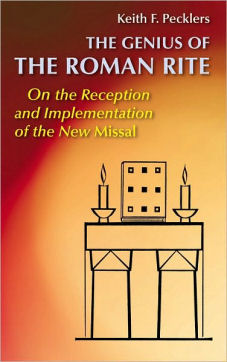
|
Posted April 15, 2010
Book: The Genius of the Roman Rite: On the reception and implementation of the New Missal Author: Keith F. Pecklers S.J. Liturgical Press. Collegeville, MN. 2010. Pp. 117 An Excerpt from the Jacket:
An Excerpt from the Book: Some Comments on the New Translations It is interesting to note that five prayers in that Grey Book for the ‘Proper of Seasons’ have conclusions which do not match the Latin original. In the case of the Collect for Monday of the Third Week of Advent, for example, the English word order requires that the Son be named earlier in the prayer than in the Latin original, making ‘Through our Lord . . .’ more appropriate. The opposite is true in th Prayer Over the Offerings for the Morning Mass on 24 December. In this case the English word order requires that the Son be named later in the prayer than in the Latin original, thus making ‘Who lives and reigns for ever and ever’ a more fitting conclusion. The Prayer After Communion for the Solemnity of the Most Holy Trinity offers yet another example. Here, to accommodate a better English word order, the Trinity is named earlier in the translated prayer than in the original Latin. ‘Through Christ our Lord’ concludes the prayer, consequently, rather than ‘Who lives and reigns for ever and ever.. The conclusions of several other prayers were also changed for reasons similar to those explained above. A second comment involves the recovery of biblical imagery within the prayer texts. Bishop Arthur Serratelli observed that the new texts have been re-worked in such a way that they strongly transmit the scriptural references that are inherent within the Roman Missal. He uses the example of the revised draft of the Collect for the First Sunday of Advent: Grant, we pray almighty God
that your faithful may resolve to run forth with righteous deeds, to meet you Christ who is coming, so that gathered at his right hand they may be worthy to possess the heavenly kingdom. increase our strength of will for doing good that Christ may find an eager welcome at his coming and call us to his side in the kingdom of heaven. Table of Contents: 1. The evolution of the Roman Rite 2. Recovering tradition: the Conciliar Reforms of Vatican II and the Post-Conciliar Liturgical Renewal 3. The process of liturgical tradition 4. The 2002 General Instruction of the Roman Missal 5. On the reception and implementation of the Third Edition of the Roman Missal 6. Conclusion: the future of liturgy is the future of the Church |
|
